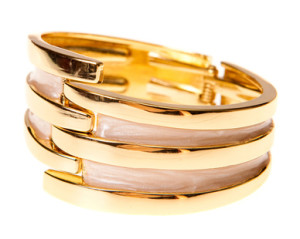What Is Gold-Filled Jewelry?
The term “gold filled” is used to describe a piece that is made of a non-gold metal covered with a thick layer of gold.

Gold-filled jewelry is not solid gold.
Gold-filled jewelry is also referred to as “rolled gold”, “gold overlay” or “rolled gold plate”.
It is usually cheaper than solid gold jewelry of the same karat.
How Is Gold-Filled Jewelry Made?
As already mentioned, gold-filled jewelry is not solid gold.
Instead, the core of the item is made of a base material (brass or nickel is often used).
A gold sheet is then wrapped around the base, and heat is used to fuse the gold layer and the underlying core together.
Karats and Gold-Filled Jewelry
The karat number of a gold-filled piece really refers to the purity of the gold sheet that is wrapped around the base metal.
Thus, if a gold-filled pendant is 10 karats, for example, this simply means that the item has an outer layer that is made of 41.7% gold, and below that top layer, there is another metal or alloy.
Most gold-filled jewelry sold is between 10 and 20 karats.
Gold-Filled Jewelry and Thickness
The thickness of the gold layer is another important characteristic of gold-filled jewelry. The thicker the layer, the longer it will take before it wears down.
Usually, gold-filled pieces are wrapped in a gold sheet that is between 0.03 and 0.1 millimeters thick.
Markings of Gold-Filled Jewelry
Gold-filled jewelry is usually stamped with the letters GF, along with the karat number and gold weight of the item.
For example, if you see a piece with a stamp such as “1/20 14K GF”, this means that it is gold filled, with an outer layer that is 14 karats, and its gold content accounts for 1/20 of the weight of the piece.
Items stamped with the letters RGP (rolled gold plate) have a thinner outer gold layer compared with items stamped GF.
Gold-Filled Jewelry and Durability
The durability of a gold-filled item depends on the thickness of its gold layer and its karat (lower karats tend to be more durable as they contain less gold, which is soft).
Some pieces can last as long as 20-30 years. Most gold-filled jewelry, however, lasts between 3 and 8 years before the gold layer begins to wear through, depending on how often you put the piece on.
Difference Between Gold-Filled and Gold-Plated Jewelry
Gold-plated jewelry is created trough a technology that is different from the one used to make gold-filled pieces, and plated items are covered with a much thinner layer of gold.
For this reason, gold-plated pieces tend to be less durable, and their gold coating wears down faster than that of gold-filled jewelry. Understandably, gold-plated items are also cheaper.
Where to Buy Gold Jewelry?
For jewelry with diamonds, emeralds, rubies, or sapphires, we recommend James Allen (read review) because it allows you to take a 360-degree look at any stone before having it set in gold.
Blue Nile is another reputable diamond retailer we recommend.














